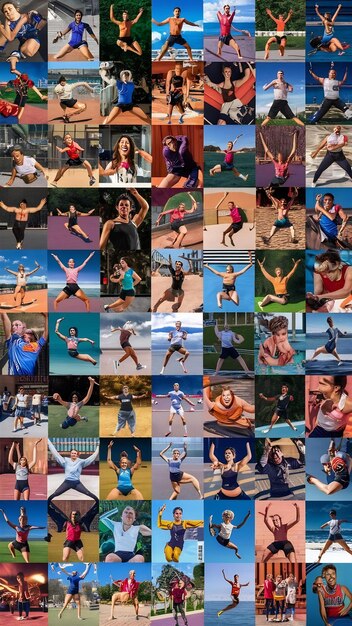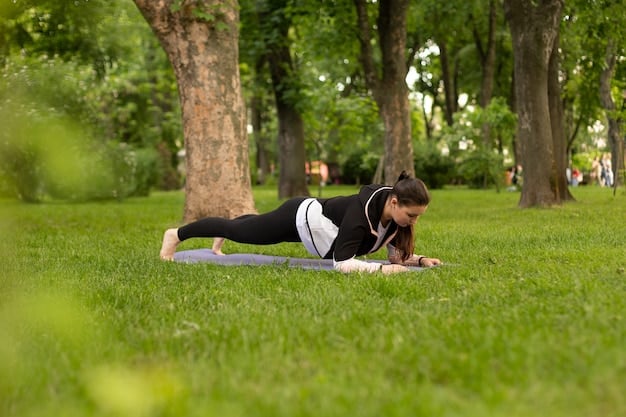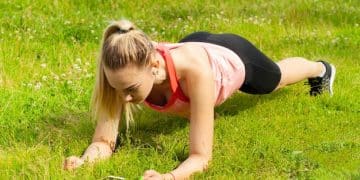Calisthenics for Muscle Growth: Your Ultimate Guide (No Gym!)

Calisthenics offers a complete bodyweight training system for building muscle effectively, regardless of location, using progressive exercises that can be tailored from beginner to advanced levels.
Want to build muscle but hate going to the gym? This Ultimate Guide to Building Muscle with Calisthenics: No Gym Required unveils the secrets to sculpting your physique using only your bodyweight, anywhere, anytime.
Unlock Your Strength: Introduction to Calisthenics
Calisthenics, the art of using your own body weight as resistance, is a timeless method for building strength, endurance, and flexibility. No longer relegated to playgrounds and military training, it has surged in popularity as a practical and effective way to achieve a muscular physique without the need for expensive gym equipment.
This guide explores the potential of calisthenics for muscle building, offering a roadmap for beginners to advanced practitioners, ensuring that everyone can begin their journey toward a stronger, more muscular self, regardless of where they are starting from.
Benefits of Calisthenics for Muscle Growth
Why choose calisthenics over traditional weightlifting? Here are several compelling reasons:
- Accessibility: You can perform calisthenics anywhere, anytime, eliminating the need for a gym membership.
- Full-Body Engagement: Many calisthenic exercises engage multiple muscle groups simultaneously, promoting functional strength and balanced development.
- Reduced Risk of Injury: By emphasizing controlled movements and using your own body weight, calisthenics minimizes the risk of injury compared to lifting heavy weights.
- Improved Body Awareness: Calisthenics enhances proprioception, or your body’s awareness in space, leading to greater coordination and control.
Calisthenics offers a holistic approach to fitness, promoting strength, agility, and body awareness, all of which can be achieved in the comfort of your own home or local park.

Mastering the Basics: Essential Calisthenics Exercises
Before attempting advanced calisthenic movements, it’s crucial to master the foundational exercises. These form the building blocks for strength and create a solid base for more complex movements, preventing injury and maximizing results.
Let’s delve into some of the most effective basic calisthenics exercises that you should be doing from the start of your calisthenics journey.
The Big Four: Foundational Exercises
These four exercises should be the cornerstone of your calisthenics routine:
- Push-ups: A classic exercise that targets the chest, shoulders, and triceps. Vary your hand placement to emphasize different muscle groups.
- Pull-ups: Essential for back and bicep development. If you can’t do a full pull-up, use assistance bands or focus on negative (lowering) pull-ups.
- Squats: The king of leg exercises. Focus on proper form to engage the quads, hamstrings, and glutes effectively.
- Plank: A core-strengthening exercise that improves stability and posture. Hold for as long as possible while maintaining proper form.
These exercises, though simple, are incredibly effective when performed with proper form and progressive overload. The key to building muscle is to constantly challenge yourself by increasing the difficulty or volume over time. Perfect form will help to avoid injury.
Progressive Overload in Calisthenics: How to Advance
Progressive overload is the principle of gradually increasing the demands on your muscles to stimulate growth. In calisthenics, this can be achieved through several methods:
- Increasing Repetitions: Aim to perform more repetitions of each exercise as you get stronger.
- Adding Sets: Increase the number of sets you perform for each exercise.
- Decreasing Rest Time: Reduce the amount of rest between sets to increase the intensity.
- Modifying Exercises: Progress to more challenging variations of exercises as you get stronger.
By consistently applying progressive overload, you can continually challenge your muscles and stimulate growth, leading to significant strength and size gains.
Targeting Muscle Groups: Calisthenics Workout Examples
While calisthenics excels at providing a full-body workout, it’s also possible to target specific muscle groups by strategically selecting and modifying exercises. With a few simple modifications, you will be able to target muscle groups.
Here are some workout examples designed to focus on specific muscle groups using calisthenics:
Upper Body Strength: Push and Pull Workout
This workout focuses on building upper body strength, targeting the chest, back, shoulders, and arms.
- Diamond Push-ups: 3 sets of 8-12 repetitions (targets triceps and inner chest)
- Incline Push-ups: 3 sets of 12-15 repetitions (targets upper chest)
- Wide-Grip Pull-ups: 3 sets of as many repetitions as possible (AMRAP) (targets back width)
- Chin-ups: 3 sets of AMRAP (targets biceps)
Adjust the difficulty of these exercises as needed to match your current strength level. Remember to focus on proper form to maximize muscle engagement and prevent injury.
Lower Body Power: Leg and Core Workout
This workout focuses on building lower body strength and core stability.
- Pistol Squats: 3 sets of 5-8 repetitions per leg (targets quads, hamstrings, and glutes)
- Bulgarian Split Squats: 3 sets of 10-12 repetitions per leg (targets quads and glutes)
- Hanging Knee Raises: 3 sets of 15-20 repetitions (targets lower abs)
- Russian Twists: 3 sets of 20-25 repetitions per side (targets obliques)
These exercises will challenge your legs, glutes, and core, leading to increased lower body power and stability. Don’t be afraid to modify the exercises or seek assistance if needed.

Advanced Calisthenics: Taking Your Training to the Next Level
Once you’ve mastered the basics, you can progress to more advanced calisthenic movements. These exercises require a significant amount of strength, skill, and body control, but they offer incredible opportunities for muscle growth and development.
Let’s explore some advanced calisthenics exercises.
Pistol Squats and Handstand Push-ups
These advanced moves test your strength, balance, and coordination. The key to mastering them lies in consistent practice and dedicated progression. Always progress slowly and use assistance as needed.
- Pistol Squats Work on mobility and hip flexibility. Start by squatting onto a box and gradually lower the height as you get stronger.
- Handstand Push-ups: Start with wall-assisted handstand push-ups to build shoulder strength. Gradually increase the range of motion as you become more comfortable.
Remember to listen to your body and avoid pushing yourself too hard, especially when first learning these advanced movements.
Combining Exercises for Maximum Impact
Once you are comfortable with the advance exercises described above, try piecing together all the movements for one giant workout to maximize the impact of the exercises.
- Muscle-ups: Combine the pull-up and dip movements to create one explosive exercise.
- L-sits: Requires incredible core strength and stability. Start by practicing tuck L-sits and gradually extend your legs as you get stronger.
By incorporating compound movements and advanced techniques, you can continuously challenge your muscles and stimulate further growth.
Nutrition and Recovery: Fueling Muscle Growth
No training program is complete without a focus on nutrition and recovery. Proper nutrition provides the building blocks for muscle growth, while adequate recovery allows your muscles to repair and rebuild after workouts. Both are crucial for maximizing the results from your calisthenics training.
Without the proper diet and recovery process, you will not be able to sustain muscle growth and will tire your body in the long run.
The Importance of Protein for Muscle Repair
Protein is essential for muscle repair and growth. Aim to consume at least 0.8 grams of protein per pound of body weight per day, especially after workouts. Good sources of protein include:
- Lean Meats: Chicken, turkey, and fish
- Eggs: A complete protein source
- Dairy Products: Milk, yogurt, and cheese
- Plant-Based Sources: Beans, lentils, and tofu
Make sure to incorporate adequate amounts of protein into your daily diet to support muscle growth.
Prioritizing Sleep and Active Recovery
Sleep is crucial for hormone regulation and muscle recovery. Aim for 7-9 hours of quality sleep per night. Additionally, incorporate active recovery techniques such as:
- Foam rolling: Loosen tight muscles and improve blood flow.
- Stretching: Improve flexibility and reduce muscle soreness.
- Light cardio: Promote blood flow and nutrient delivery to muscles.
By prioritizing sleep and active recovery, you can reduce muscle soreness, prevent injuries, and optimize muscle growth.
Common Mistakes to Avoid in Calisthenics
While calisthenics is a safe and effective form of exercise, it’s essential to avoid common mistakes that can hinder your progress or lead to injury. A mistake in certain calisthenics routines can lead to injury so understanding these risks can help you avoid injury.
Here are some common mistakes to avoid in calisthenics:
Neglecting Warm-up and Cool-down
Always start your workout with a proper warm-up and end with a cool-down and stretching routine. A proper warm-up prepares your muscles for exercise. Cool downs help prevent muscle soreness
Ignoring Proper Form
Focus on maintaining proper form throughout each exercise. Avoid sacrificing form for repetitions, as this can lead to injury. Remember to perfect your form along the way.
Skipping Progressive Overload
Consistently challenge your muscles by gradually increasing the difficulty or volume of your workouts. It is important to overload the muscles.
By avoiding these common mistakes, you can maximize the benefits of calisthenics and minimize the risk of injury. Calisthenics is a safe workout that leads to minimal injuries.
| Key Point | Brief Description |
|---|---|
| 💪 Mastering Basics | Focus on push-ups, pull-ups, squats to build a strong foundation. |
| 📈 Progressive Overload | Increase reps, sets, or difficulty to continuously challenge muscles. |
| 🍎 Nutrition & Rest | Consume enough protein and prioritize sleep for muscle repair and growth. |
| 🚫 Avoid Mistakes | Proper warm-up, form, and overload essential to prevent injury. |
Frequently Asked Questions
▼
Yes, calisthenics can effectively build muscle, especially when using progressive overload and advanced exercises. It might require more creativity in programming, but the results are comparable to weightlifting.
▼
Aim for 3-4 calisthenics workouts per week, allowing for rest and recovery between sessions. Consistency is important, and it is important to give your body rest in-between workouts.
▼
Start with easier variations like negative pull-ups (focusing on the lowering phase) or using an assistance band and over time, you will be able to do it.
▼
No, that’s the beauty of calisthenics! Your body is the equipment. A pull-up bar can broaden the exercise selection, but you can start with no equipment.
▼
With consistent training and proper nutrition, you can expect to see noticeable changes in strength and muscle mass within 8-12 weeks. However, individual results may vary.
Conclusion
Calisthenics offers an accessible and effective path to build muscle and improve overall fitness without the need for a gym. By mastering the basics, progressively challenging yourself, and prioritizing nutrition and recovery, you can unlock your full potential and achieve a strong, muscular physique using nothing but your own body weight. Start today and witness the transformation firsthand!





